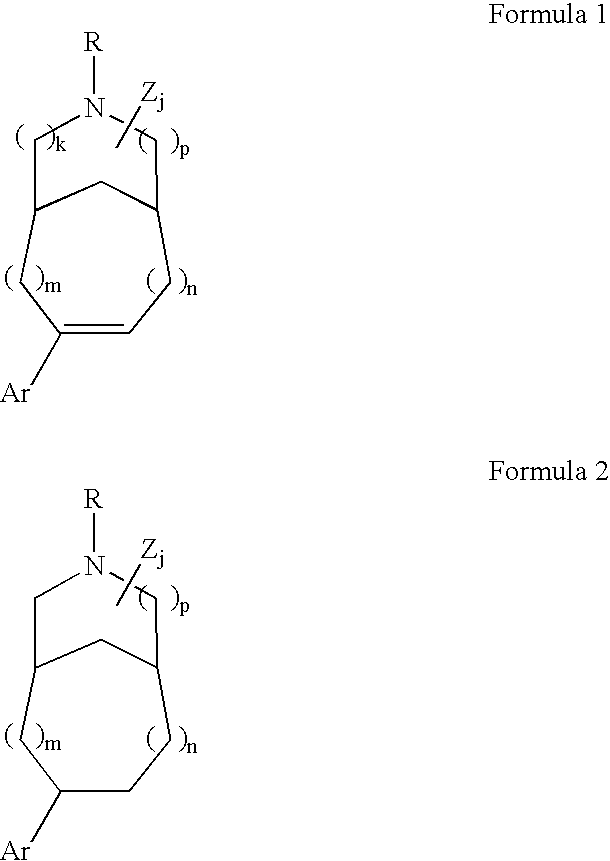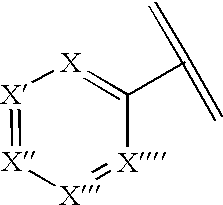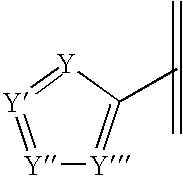Pharmaceutical compositions and methods for relieving pain and treating central nervous system disorders
a technology of central nervous system and compositions, applied in the field of pharmaceutical compositions, can solve the problems of profound decline in the psychosocial affect of the subject suffering therefrom, difficulty in concentrating, listening, learning and completing tasks, restlessness, etc., and achieve the effects of reducing the number of nachrs of the brain of the patient, preventing or suppressing symptoms, and increasing blood pressure and heart ra
- Summary
- Abstract
- Description
- Claims
- Application Information
AI Technical Summary
Benefits of technology
Problems solved by technology
Method used
Image
Examples
example 1
[0492] Example No. 1 is the pair of isomers, 3-(3-pyridinyl)-6-azabicyclo [3.2.1]oct-2-ene dihydrochloride and 3-(3-pyridinyl)-6-azabicyclo[3.2.1] oct-3-ene dihydrochloride, which were prepared in accordance with the following techniques:
4-Iodo-6-oxabicyclo[3.2.1]octan-7-one
[0493] To a suspension of 3-cyclohexenecarboxylic acid (5.0 g, 40 mmol) in water (200 ml) was added, with vigorous stirring, sodium bicarbonate (9.90 g, 118 mmol). A solution of potassium iodide (39.0 g, 235 mmol) in water (125 ml) was prepared, and to this iodine (10 g, 40 mmol) was added to give a brown solution. This solution was added in one portion to the vigorously stirring solution of cyclohexenecarboxylate. The mixture was stirred at room temperature in the dark for 18 h. The resulting yellow solid was collected by filtration. The damp solid was dissolved in chloroform (150 ml) and washed with sodium thiosulfate solution (2×25 ml), and then with brine (25 ml). It was dried over magnesium sulfate, filter...
example 2
[0503] Example No. 2 is 3-(3-pyridinyl)-6-azabicyclo[3.2.1]octane, which was prepared in accordance with the following techniques:
3-(3-pyridinyl)-6-azabicyclo[3.2.1]octane
[0504] To a solution of a mixture of t-butyl 3-(3-pyridinyl)-6-azabicyclo[3.2.1] oct-2-ene-6-carboxylate and t-butyl 3-(3-pyridinyl)-6-azabicyclo[3.2.1] oct-3-ene-6-carboxylate (150 mg) in methanol (5 ml) was added catalytic 10% Pd / C and the mixture was subjected to hydrogenolysis (45 psi) for 48 h. The reaction was filtered through Celite and concentrated by rotary evaporation, and then the residue was taken up in dichloromethane (1 ml) and treated with trifluoroacetic acid (2 ml). After 3 h, the mixture was concentrated to dryness by rotary evaporation, partitioned between water and dichloromethane, and the organic layer discarded. The aqueous layer was made basic with sodium hydroxide and extracted with dichloromethane. After drying over sodium sulfate, the filtered solution was concentrated to dryness by rota...
example 3
[0505] Example No. 3 is the pair of regioisomers, 3-(6-methoxy-3-pyridinyl)-6-azabicyclo[3.2.1]oct-2-ene dihydrochloride and 3-(6-methoxy-3-pyridinyl)-6-azabicyclo[3.2.1]oct-3-ene dihydrochloride, which were prepared in accordance with the following techniques:
3-(6-Methoxy-3-pyridinyl)-6-azabicyclo[3.2.1]oct-2-ene dihydrochloride and 3-(6-methoxy-3-pyridinyl)-6-azabicyclo[3.2.1]oct-3-ene dihydrochloride
[0506] To a solution of a mixture of t-butyl 3-trifluoromethanesulfonyloxy-6-azabicyclo[3.2.1]oct-2-ene-6-carboxylate and t-butyl 3-trifluoromethanesulfonyloxy-6-azabicyclo[3.2.1]oct-3-ene-6-carboxylate (120 mg, 0.336 mmol) in dimethoxyethane (2 ml) was added a saturated solution of sodium carbonate (0.5 ml), lithium chloride (42 mg, 1 mmol) and 2-methoxy-5-pyridinylboronic acid 1,3-propanediol cyclic ester (96 mg, 0.5 mmol). The reaction flask was evacuated under high vacuum and filled with nitrogen three times, then palladium tetrakis(triphenylphosphine) catalyst was added (20 mg)...
PUM
| Property | Measurement | Unit |
|---|---|---|
| Antimicrobial properties | aaaaa | aaaaa |
| Level | aaaaa | aaaaa |
| Stereoisomer | aaaaa | aaaaa |
Abstract
Description
Claims
Application Information
 Login to View More
Login to View More - R&D
- Intellectual Property
- Life Sciences
- Materials
- Tech Scout
- Unparalleled Data Quality
- Higher Quality Content
- 60% Fewer Hallucinations
Browse by: Latest US Patents, China's latest patents, Technical Efficacy Thesaurus, Application Domain, Technology Topic, Popular Technical Reports.
© 2025 PatSnap. All rights reserved.Legal|Privacy policy|Modern Slavery Act Transparency Statement|Sitemap|About US| Contact US: help@patsnap.com



